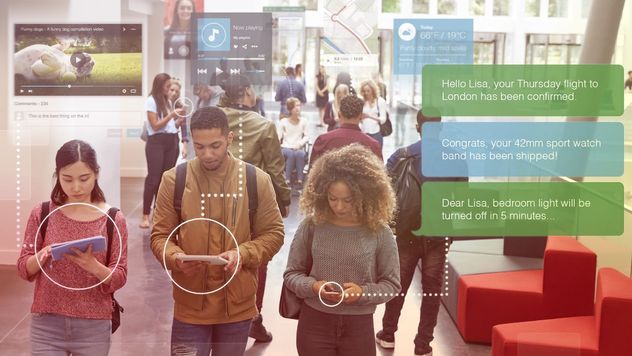
Voice command technology has mostly been used in smartphones and computers in recent years, but today it’s becoming increasingly common for voice assistants to be incorporated into virtual and home assistant devices, consumer products, appliances, customer service offerings, e-commerce, and more. In fact, as the technologies required to operate voice assistants continue to improve, so too will it become increasingly common for consumers to expect this level of interaction from the brands they support. Most of us are already using voice commands on their smartphones, and it’s expected that this technology will be installed on over 7.5 billion devices by the year 2021. At the 2018 CES event in Las Vegas, there were numerous new prototypes and products that integrated voice assistant technology, proving that this trend is sticking around for good, especially in the world of e-commerce.
Just look at recent news surrounding Amazon’s Alexa, whether she’s “losing her voice” for a Superbowl ad or the now infamous “laughing incident”, consumers are becoming more familiar and reliant on voice assistants. But as different brands and e-commerce companies find creative ways to implement voice assistants and more consumers become familiar with the technology, more companies are going to have to seriously consider how to integrate voice commands into their own customer products and experience, which is being revolutionized by this fun and interactive technology.
The Current State of Voice Assistants: Web Searches, Questions, and Voice Command Calling
We’re all familiar with the concept of voice assistants thanks to the voice command technology that modern smartphones are equipped with, such as Siri for Apple devices, Google Assistant, and Samsung’s S Voice. In fact, in 2017 the Pew Research Center polled internet users and found that 42 percent used virtual assistant technology via their smartphones, whether it’s to ask questions, set reminders, locate goods and services, or initiate calls.
One of the major reasons why we use voice commands is the convenience that the technology provides, allowing us to multitask more effectively by allowing us to use our devices without having to type or look at the screen. The same Pew Research data showed that 80 percent of voice assistant users liked the idea of not having to touch their device. Talking is also more natural than writing, and significantly faster: whereas most people can only type 40 words per minute, they can say upwards of 175 words in the same amount of time. Nonetheless, the use of voice command devices is still largely limited to smartphones, computers, and home assistants. Moreover, there are only a few basic reasons why most of us use the technology, with common voice command examples including:

Tasks Canadians like to do with Digital Assistants are finding directions 58%, ordering food delivery 40%, making restaurant reservations 40%, making/managing shopping lists 36%.
Technology Evolution and the Rise of Home Assistants
In the last couple of years, tech companies like Amazon have been finding innovative ways to use voice technology, ultimately giving birth to the voice command home assistant. These virtual assistants include devices like Alexa by Amazon, Samsung’s Bixby, and Google Home, and we use them to find answers to questions, get weather or traffic updates, control various features around the house, order takeout, and much more. These devices have convenience as their number one goal, requiring only addressing the device to activate it, and then pose a question or initiate a command. For instance, a popular voice command for Alexa is “Alexa, show me my photos,” at which time the voice assistant will access the photos on your smartphone and display them.

Technological Developments are Expanding the Potential of Voice Assistants
Voice command recognition algorithm technology is still in its nascent stages, and new developments are happening all the time that are making voice assistants more appealing and easier to use. Plus, these developments are also increasing the applications for the technology, which is why the use of voice assistants will only continue to grow in the coming years. For example, natural language processing has taken some major steps forward in recent years, and since 2012, Google alone has reduced its speech recognition error rate by over 30 percent. Another major development that’s making voice assistants more viable is the cloud because devices can use remote servers to process information and requests rather than a device’s own processor, and this makes the technology far more powerful. Finally, artificial intelligence and machine learning mean that voice assistants can improve themselves over time by learning from previous interactions, and this also means that devices will get better at remembering user preferences and histories.

Factors that are improving voice assistants are development of cloud, artificial intelligence and machine learning, emergence of new developments and applications, reduced speech recognition error rate.
Unlocking the Possibilities: How is Voice Command the Future of Customer Experience?
Voice assistant technology isn’t limited to virtual assistants and mobile devices, and there are a number of applications where this technology is currently being implemented to enhance customer products and experiences. For example, voice command technology is a natural fit with home appliances, and companies like GE, Whirlpool, Samsung, LG, have already partnered with Amazon (Alexa), Bixby, as well as Google Home to manufacture microwaves, washing machines, cooking ranges, refrigerators, and other smart appliances that are voice activated and can provide consumers with interactive customer experiences. In fact, you can use your digital assistants to get your stocks up in the refrigerator, clean your dishes, do the laundry, and more using the smart connected appliances. However, this technology isn’t limited to in the home as we’ve seen from the insurance company Lemonade who is using voice assistants to provide incomparable customer service, and they’ve created an AI bot named Jim who can process claims and approve payments in record time.
As more developments happen in this field in the coming months and years, voice-enabled devices, items, and customer service offerings will only continue to become more ubiquitous as well. Recent studies by MasterCard and Mercator found that 21 percent of voice assistant users in the US use the technology for more complex e-commerce and banking functions. The same study also found that users are becoming more trustworthy of the security and privacy settings of these devices, which will open more options for banking, telecom, and retail. Here at home, Google reported that 73 percent of Canadians would like to complete tasks by speaking to a digital assistant, and according to Tractica, by 2020 there will be over 1.6 billion digital assistant users.
Although most voice assistant use still resides in the realm of smartphones and home, there will be newer ways to incorporate this technology into products and services. To stay relevant, we need to start incorporating the fastest growing consumer technology for 2018 or risk getting left behind.
Looking to add some voice to your experience? Let’s Connect



